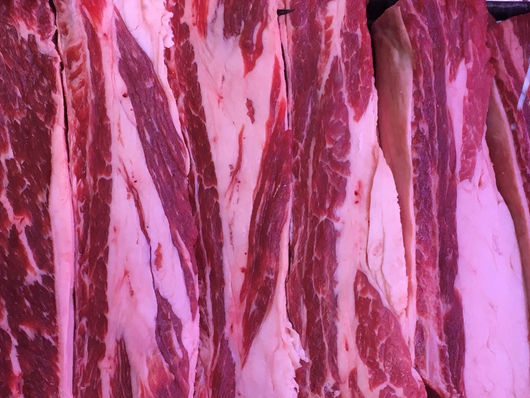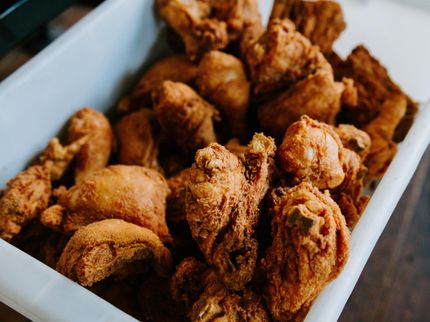Lab-grown fat could give cultured meat real flavor and texture
Researchers have successfully produced cultivated fat tissue in a way that could help enable large-scale production of more flavorful cultured meat
Researchers at Tufts University have successfully bulk-produced fat tissue in the lab that has a similar texture and make-up to fat tissue naturally occurring in animals. The results, described in a study published today in eLife, could be applied to the production of cultured meat grown entirely from cells, giving it a more realistic texture and flavor.

Fat contributes texture and distinct flavor to farm raised beef (shown here) and other meats. Researchers have replicated the texture and composition of natural fat in fat tissue grown from cells.
Mike Silver, Tufts University
Startup companies around the world are developing cultivated meat—cell-grown chicken, beef, pork, and fish. Most are in early stages of development, not ready for large-scale production and, with a couple of exceptions, not yet approved for commercial sale.
Most of those products in development are in the form of an unstructured mixture of cells—think chicken nuggets instead of a slice of chicken breast. What is lacking is the real texture of a fillet or steak—a texture created by muscle fibers, connective tissue, and fat.
It’s the fat that contributes not only texture, but also to its delicious flavor to the meat. Consumer tests with natural beef of varying fat content showed the highest scores for beef containing 36% fat.
Producing cultured fat tissue in sufficient quantities has been a major challenge, because as the fat grows into a mass, the cells in the middle become starved of oxygen and nutrients. In nature, blood vessels and capillaries deliver oxygen and nutrients throughout the tissue. Researchers still have no way to replicate that vascular network at large scale in lab-grown tissue, so they can only grow muscle or fat to a few millimeters in size.
To get around this limitation, the researchers grew fat cells derived from mice and pigs first in a flat, two-dimensional layer, then harvested those cells and aggregated them into a three-dimensional mass with binders such as alginate (developed from seaweed) and microbial transglutaminase (MTG), which are both already used in some commercial foods.
“Our goal was to develop a relatively simple method of producing bulk fat. Since fat tissue is predominantly cells with few other structural components, we thought that aggregating the cells after growth would be sufficient to reproduce the taste, nutrition, and texture profile of natural animal fat,” said John Yuen Jr., a graduate student working at the Tufts University Center for Cellular Agriculture (TUCCA). “This can work when creating the tissue solely for food, since there’s no requirement to keep the cells alive once we gather the fat in bulk.”
Taste and Feel
The aggregated fat cells immediately had the appearance of fat tissue, but to see if they truly reproduced the features of native fat from animals, the team carried out a further series of experiments.
First, they explored the texture, by compressing the fat tissue and seeing how much pressure it could withstand compared to natural animal fat. They found that cell-grown fat bound with alginate was able to withstand a similar amount of pressure as fat tissue in livestock and poultry, and that the cell-grown fat bound with MTG behaved more like rendered fat, similar to lard or tallow. This suggests it could be possible to fine-tune the texture of cultured fat using different types and amounts of binders, so that it most closely resembles the real-life texture of fat within meat.
The molecular composition of fat is important, too. Cooking releases hundreds of compounds that add flavor and aroma to the meat, and most of those compounds originate from fat, including lipids and their component fatty acids.
The Tufts research team examined the composition of molecules from the cell-grown fat and found that the mix of fatty acids from cultured mouse fat differed from native mouse fat, but that cultured pig fat had a much closer fatty acid profile to the native tissue. The team’s preliminary research suggests it might be possible to supplement growing fat cells with different lipids to ensure that they more closely match the fatty acid composition of natural meat.
“This method of aggregating cultured fat cells with binding agents can be translated to large-scale production of cultured fat tissue in bioreactors—a key obstacle in the development of cultured meat,” said David Kaplan, Stern Family professor of biomedical engineering at Tufts and director of TUCCA. “We continue to look at every aspect of cultured meat production with an eye toward enabling mass production of meat that looks, tastes, and feels like the real thing.”
TUCCA has been leading the development of a growing industry in cellular agriculture, and along with a consortium of academic and corporate members – the TUCCA Consortium – it is solving key technological challenges in cell grown meat production. Their vision is nothing less than ushering in a 3rd epoch in human harvesting of food -- from hunting to domesticated animal farming to cellular agriculture





























































